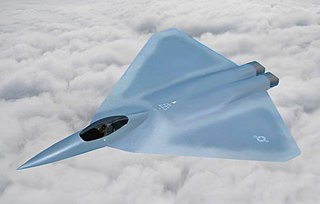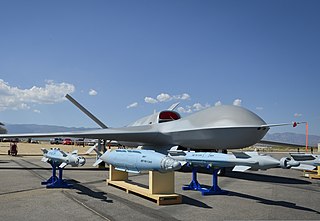
The Northrop B-2 Spirit, also known as the Stealth Bomber, is an American heavy strategic bomber, featuring low-observable stealth technology designed to penetrate dense anti-aircraft defenses. A subsonic flying wing with a crew of two, the plane was designed by Northrop as the prime contractor, with Boeing, Hughes, and Vought as principle subcontractors, and was produced from 1987 to 2000. The bomber can drop conventional and thermonuclear weapons, such as up to eighty 500-pound class (230 kg) Mk 82 JDAM GPS-guided bombs, or sixteen 2,400-pound (1,100 kg) B83 nuclear bombs. The B-2 is the only acknowledged in-service aircraft that can carry large air-to-surface standoff weapons in a stealth configuration.

The Rockwell B-1 Lancer is a supersonic variable-sweep wing, heavy bomber used by the United States Air Force. It has been nicknamed the "Bone". It is one of the Air Force's three strategic bombers, along with the B-2 Spirit and the B-52 Stratofortress, as of 2024. Its 75,000-pound payload is the heaviest of any U.S. bomber.

The Lockheed F-117 Nighthawk is a retired American single-seat, subsonic twin-engine stealth attack aircraft developed by Lockheed's secretive Skunk Works division and operated by the United States Air Force (USAF). It was the first operational aircraft to be designed with stealth technology.

The Lockheed Martin/Boeing F-22 Raptor is an American twin-engine all-weather stealth fighter aircraft developed and produced for the United States Air Force (USAF). As a product of the USAF's Advanced Tactical Fighter (ATF) program the aircraft was designed as an air superiority fighter, but also incorporates ground attack, electronic warfare, and signals intelligence capabilities. The prime contractor, Lockheed Martin, built most of the F-22's airframe and weapons systems and conducted final assembly, while program partner Boeing provided the wings, aft fuselage, avionics integration, and training systems.

The General Dynamics F-111 Aardvark is a retired supersonic, medium-range, multirole combat aircraft. Production models of the F-111 had roles that included attack, strategic bombing, reconnaissance and electronic warfare. Aardvark comes from a South African animal that has a long nose and hugs the terrain. It is an Afrikaans word that translates literally as "earth pig" — hence the aircraft's "Pig" nickname during its Australian service.

Paveway is a series of laser-guided bombs (LGBs).

Stealth aircraft are designed to avoid detection using a variety of technologies that reduce reflection/emission of radar, infrared, visible light, radio frequency (RF) spectrum, and audio, all collectively known as stealth technology. The F-117 Nighthawk was the first operational aircraft explicitly designed around stealth technology. Other examples of stealth aircraft include the B-2 Spirit, the B-21 Raider, the F-22 Raptor, the F-35 Lightning II, the Chengdu J-20, and the Sukhoi Su-57.

The McDonnell DouglasF-15E Strike Eagle is an American all-weather multirole strike fighter derived from the McDonnell Douglas F-15 Eagle. The F-15E was designed in the 1980s for long-range, high-speed interdiction without relying on escort or electronic-warfare aircraft. United States Air Force (USAF) F-15E Strike Eagles can be generally distinguished from other US Eagle variants by darker aircraft camouflage, conformal fuel tanks (CFTs) mounted along the engine intake ramps and a tandem-seat cockpit.

The Northrop/McDonnell Douglas YF-23 is an American single-seat, twin-engine, supersonic stealth fighter aircraft technology demonstrator designed for the United States Air Force (USAF). The design team was a finalist in the USAF's Advanced Tactical Fighter (ATF) demonstration/validation competition, battling the YF-22 team for the full-scale development contract. Two YF-23 prototypes were built.

The Lockheed Martin X-44 MANTA was an American conceptual aircraft design by Lockheed Martin that has been studied by NASA and the U.S. Air Force. It was intended to test the feasibility of full yaw, pitch and roll authority without tailplanes. Attitude control relies purely on 3D thrust vectoring. The aircraft design was derived from the F-22 Raptor and featured a stretched delta wing without tail surfaces.

The General Dynamics/McDonnell Douglas A-12 Avenger II was a proposed American attack aircraft from General Dynamics and McDonnell Douglas. It was to be an all-weather, carrier-based stealth bomber replacement for the Grumman A-6 Intruder in the United States Navy and Marine Corps. Its Avenger II name was taken from the Grumman TBF Avenger of World War II.

The Advanced Tactical Fighter (ATF) was a program undertaken by the United States Air Force to develop a next-generation air superiority fighter to counter emerging worldwide threats, including Soviet Sukhoi Su-27 and Mikoyan MiG-29 fighters under development in the 1980s, Beriev A-50 airborne warning and control system (AWACS), and increasingly sophisticated surface-to-air missile systems. Lockheed and Northrop were selected in 1986 to respectively develop the YF-22 and the YF-23 technology demonstrator aircraft for the program's demonstration and validation (Dem/Val) phase. These aircraft were evaluated in 1991 and the Lockheed design was selected for full-scale development, or engineering and manufacturing development (EMD), and later developed into the F-22 Raptor for production and operational service.

The Boeing X-32 is a concept demonstrator aircraft that was designed for the Joint Strike Fighter competition. It lost to the Lockheed Martin X-35 demonstrator, which was further developed into the Lockheed Martin F-35 Lightning II.

The Lockheed/Boeing/General Dynamics YF-22 is an American single-seat, twin-engine fighter aircraft technology demonstrator designed for the United States Air Force (USAF). The design was a finalist in the USAF's Advanced Tactical Fighter (ATF) competition, and two prototypes were built for the demonstration/validation phase of the competition. The YF-22 team won the contest against the YF-23 team for full-scale development, and the design was developed into the Lockheed Martin F-22 Raptor. The YF-22 has a similar aerodynamic layout and configuration as the F-22, but with notable differences in the overall shaping such as the position and design of the cockpit, tail fins and wings, and in internal structural layout.

The Lockheed P-7 was a four turboprop-engined patrol aircraft ordered by the U.S. Navy as a replacement for the P-3 Orion. The external configuration of the aircraft was to be very similar to that of the P-3. Development had not progressed very much before the program was cancelled in July 1990.

The GBU-57A/BMassive Ordnance Penetrator (MOP) is a precision-guided, 30,000-pound (14,000 kg) "bunker buster" bomb used by the United States Air Force. It is substantially larger than the deepest-penetrating bunker busters previously available, the 5,000-pound (2,300 kg) GBU-28 and GBU-37.

The Boeing B-52 Stratofortress is an American long-range, subsonic, jet-powered strategic bomber. The B-52 was designed and built by Boeing, which has continued to provide support and upgrades. It has been operated by the United States Air Force (USAF) since the 1950s, and NASA for over 40 years. The bomber can carry up to 70,000 pounds (32,000 kg) of weapons and has a typical combat range of around 8,800 miles (14,200 km) without aerial refueling.

The General Atomics MQ-20 Avenger is a developmental unmanned combat aerial vehicle built by General Atomics Aeronautical Systems for the U.S. military.

The GBU-39/B Small Diameter Bomb (SDB) is a 250-pound (110 kg) precision-guided glide bomb that is intended to provide aircraft with the ability to carry a higher number of more accurate bombs. Most US Air Force aircraft will be able to carry a pack of four SDBs in place of a single 2,000-pound (910 kg) bomb. It first entered service in 2006. The Ground Launched Small Diameter Bomb (GLSDB) was later developed to enable the SDB to be launched from a variety of ground launchers and configurations.
The Lockheed Martin Sea Ghost was a proposal to fulfill the United States Navy's requirement for an Unmanned Carrier-Launched Airborne Surveillance and Strike aircraft.


















